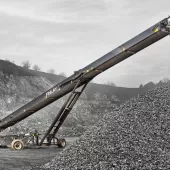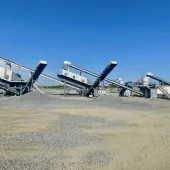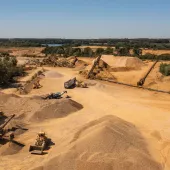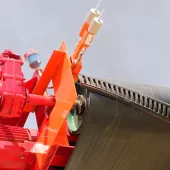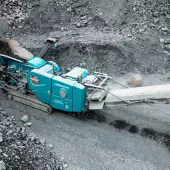Canning Conveyor complete conveyor extension for Lafarge Tarmac
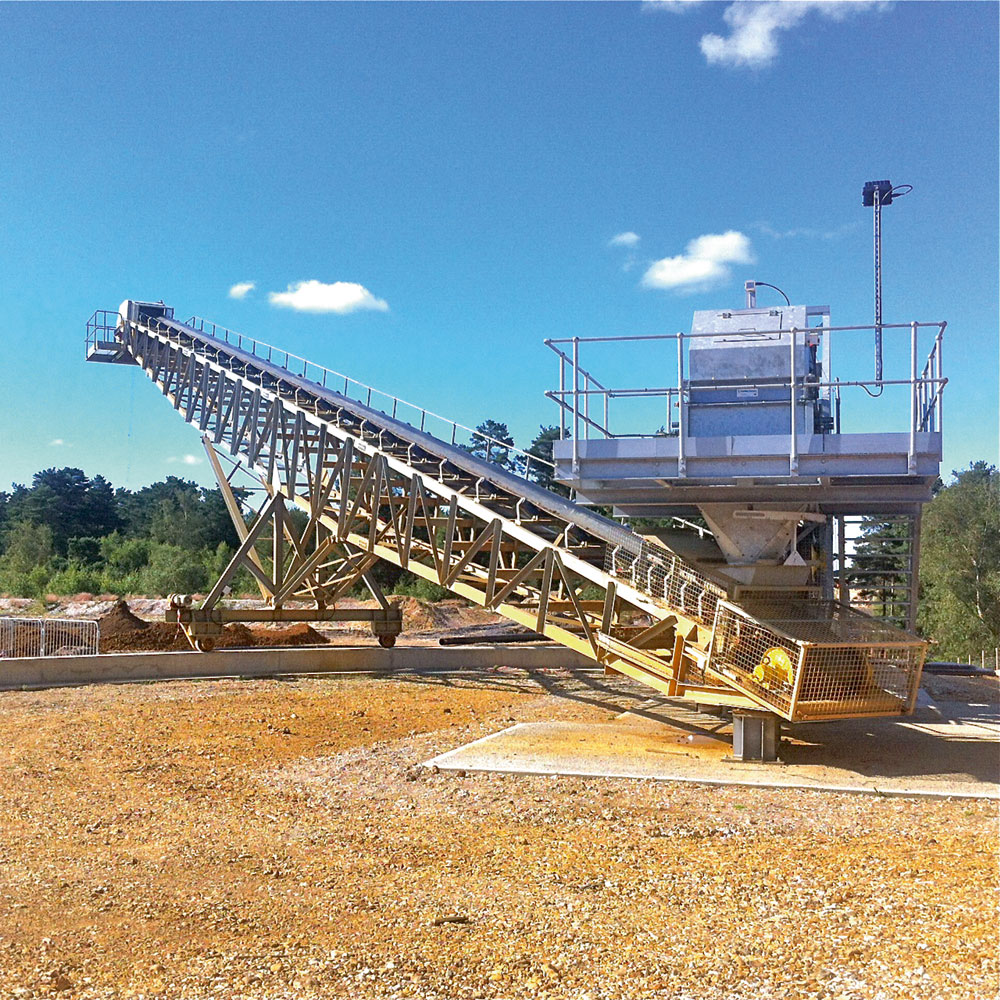
First published in the October 2013 issue of Quarry Management as Well Connected
Canning Conveyor complete final section of extended conveyor system at Lafarge Tarmac’s Blashford Quarry
With what may be one of the longest conveyor systems in the UK quarrying industry, Worksop-based Canning Conveyor have recently completed the final stage of an extension to a 2.5km field conveyor system at Blashford Quarry, near Ringwood, in Hampshire. Owned and operated by Lafarge Tarmac, present extraction operations at the site are centred on Nea Farm, which supplies processed materials to concrete plants, builders’ merchants and local contractors in the Ringwood and Bournemouth area.
Upgrading the original conveyor system
Responsible for all of the design, manufacturing and installation work, Canning Conveyor have been involved with the project since 2006/7 (ahead of the more recent plant developments at the quarry – see QM Sept 2012) when Lafarge Tarmac made the decision to upgrade the site’s existing 2.5km conveyor system to harmonize the drives on the 14 conveyors and to increase the handling capacity from 150 tonnes/h to 350 tonnes/h, bringing with it the additional benefits of improved reliability and reduced maintenance costs. This upgrade involved extending the conveyor system at the face with a new 120m long field conveyor. Canning then made further modifications by splitting an existing conveyor and interfacing a new 20m long elevated lattice section with walkway, which is powered by a ceramic-lagged SuperDrive motorized drive drum. Further modifications to an existing horizontal conveyor entailed a new 22m long elevated transfer conveyor complete with tail-end loading section, again powered by a SuperDrive motorized drive drum. This section of the plant was completed with the supply of a new 22m long troughed-belt radial stockpile conveyor.
Further improvements involved a complete retrofit of 10 ceramic-lagged Canning SuperDrive units to the whole of the existing conveyor system, along with replacement jib discharge and high- and low-tension bend drums. One of the conveyors is driven by two double SuperDrive units due to both the length of the conveyor and previous problems with belt slippage. In addition, new belt scrapers were supplied throughout the system, as necessary, along with new heavy-duty mesh guards where appropriate. In a final stage, 34 non-drive drums were supplied as the existing units would not have been capable of handling the upgrade to the system. This upgraded 2.5km field conveyor system now delivers material to the new sand and gravel plant commissioned in June 2011.
Plumley Wood extension
Having successfully secured planning permission in 2008 for the extraction of a further 6 million tonnes of reserves at Plumley Wood, Lafarge Tarmac have ensured the continuation of operations at Blashford for a period of up to 25 years. At their furthest extent in around 10 years’ time, extraction operations at Plumley Wood will reach a point some 2.5km beyond the current dig at Nea Farm and approximately 5km (around one hour’s conveyor travel) from the processing plant.
With approval granted for the extension to Plumley Wood, in 2011 Canning Conveyor were appointed to commence work on the design, manufacture and installation of further additions and modifications to the already extensive field conveyor system.
The first phase of the installation involved the incorporation of two new conveyors designed to accept up to 350 tonnes/h of –150mm sand and gravel. Running over generally level ground (maximum rise of 5m), the first, a 225m long field conveyor, is driven by a single-drum motorized SuperDrive unit and was supplied on a substantial skid-mounted frame with cantilevered jib discharge. This conveyor extends over the Plumley Wood dig to feed a new 460m long field conveyor, again running over generally level ground (maximum rise of 10m). This second conveyor is driven by a double-drum motorized SuperDrive unit and was also supplied on a substantial skid-mounted frame with cantilevered jib discharge. The discharge section of this conveyor is extended and raised to feed the radial stockpile conveyor in any of its intended positions. The jib discharge on this unit was also extended to cantilever over the rotating tail section of the radial stockpile conveyor on to which it is designed to feed.
A second field conveyor running from Plumley Wood to the Burnt Hill area (see QM June 2013) runs over a 30m length of lattice-frame gantry. Designed by Canning to span a boggy area of ground prior to elevating uphill to the Burnt Hill area, this lattice bridge was fabricated from braced and stiffened rolled steel sections and set on concrete foundation bases (supplied by others). Fully galvanized, it is fitted with full-length spill trays and a 1m wide open-mesh walkway with handrails.
Second phase
The second phase involved the installation of a new 160m long field conveyor. Driven by a single-drum motorized SuperDrive unit, this conveyor features a 12m long loading section designed to accept loads from the repositioned radial stockpile conveyor via a discharge chute that delivers vertically via a series of crash boxes through a 10m high cascade chute from the future Burnt Hill screen discharge conveyor and from a future reload hopper/feeder belt.
Running over generally level ground (maximum rise of 5m) from Burnt Hill, over a bridge to the Nea Farm side of Harbridge Drove, this conveyor feeds a second, 530m long, field conveyor. Driven by a double-drum motorized SuperDrive unit, this conveyor, in turn, feeds a third, 390m long, field conveyor driven by a single-drum motorized SuperDrive unit, which subsequently feeds on to a new extended tail-end loading section. This new loading section has replaced the existing tail unit on C11, which has been utilized on one of the new field conveyors. The new tail unit was then repositioned, with the existing C12 shortened and the head repositioned to allow the new C11 tail unit to accept the feed from both the existing C12 and the new 390m long conveyor.
Specification
Canning Conveyor supplied a standard specification throughout, comprising:
- Cannoflex troughed conveyor belts, 750mm wide EP300/3 ply belting with 5mm + 1.5mm covers
- Ceramic-lagged drive drums with internal backstop
- High-tension bend pulley, jib discharge and loop bend drum
- Primary and secondary belt scrapers
- Discharge chute with integral crash box and hinged inspection hatch
- Loop take-up unit
- Heavy-duty tail-end loading section complete with troughed impact idlers and tail drum
- Standard intermediate bays - 750mm wide x 3.048m long
- Emergency stop pull-wire system
- Full-length polycarbonate belt covers.
Electrical installation
In addition to the design, supply and installation of the conveyor system, Canning Conveyor also designed and installed a bespoke control panel positioned next to the head end of each conveyor. Each panel contains a soft-starter, capable of starting the conveyor under load conditions, with circuit and overload protection. Designed to start in sequence, the system only allows a conveyor to start if the succeeding conveyor is running, this being indicated by a rotation sensor fitted on the tail of each conveyor. A design feature also interlocks C5 with the current conveyor feeding on to C12, so that either the new conveyor system or the existing conveyor can run – but not both together, thus preventing overloading of C12. Each conveyor is also fitted with a pre-start alarm and a halide light located at the head section. A bespoke control panel was also supplied and installed for the radial stacker with traverse buttons to allow the material to be stacked around the head section.
The next 25 years
The complete installation, now fully installed and operational, is providing the processing operation with immediate benefits, including significant improvements in energy efficiency and reliability.
For further information visit: www.canningconveyor.co.uk
- Subscribe to Quarry Management, the monthly journal for the mineral products industry, to read articles before they appear on Agg-Net

